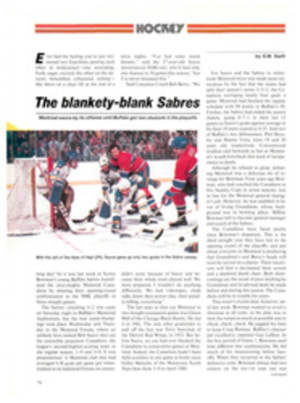
THERE'S NO NEED TO THROW A TANTRUM IF YOU CAN THROW A TENNIS RACKET
In tennis, the racket thrower is considered the lowest form of life. Posh clubs tolerate his outbursts but wish he would join the rival outfit across town. On public courts other players shake their heads in disapproval when he slams his racket. Etiquette clearly doesn't allow that sort of conduct.
But it should! The time has come to make some positive statements about racket throwing. Properly executed, the racket throw is the most satisfying move on the court. It releases tension, harms no one and stimulates the sporting goods industry to ever greater efforts to produce an indestructible racket. At its best, it's a bellowing act of self-disgust, an expression of perfect congruence between inner feeling and outward action that vents all the anger gathered in other areas of life and leaves the thrower free to be an amiable fellow. How many business tensions have accompanied a racket over the fence? How many petty frustrations have exploded along with a racket on the court? Indeed, the throw is an elegant protest against the condition of being human and fallible.
There's abundant historical and experimental evidence to suggest that our natural urge to throw rackets has been artificially stifled by the traditions of sportsmanship and the genteel origin of tennis. Blaming the racket for a missed shot is logical. The English had a concept in medieval times called deodand, whereby inanimate objects were held responsible for the harm they caused. And even now, who has not thrown a wrench after it has slipped and scraped a knuckle?
The problem with racket throwing is that not just anyone can stumble onto a court and throw well. It's true that the physical act of tossing it is simple enough, but as with so many other things, it's not so much the toss as how it's executed that's important.
The only requirements for good racket throwing, strictly speaking, are a racket and an unsteady game. True, some quality players have been known to produce prodigious heaves, but generally they're not as practiced in the art as hackers, who perfect better techniques through repetition. A sparkling exception to this rule is occasionally pulled off by a proficient player who throws his racket after a winning, but not perfect, shot to indicate that the shot didn't measure up to his high standards of play. Frequently, such action will undermine the morale of his opponent.
Some thought should go into selection of a proper throwing racket. Metal and graphite rackets sail farther, but wood on pavement makes a more satisfying sound. Opinion is split—as are many rackets—over whether cost can enhance the beauty of a throw. There's something breathtaking about a $200 graphite sailing through the air, but since the object of the throw is emotional expression, a drugstore special should do. You should buy a racket appropriate to your means that feels good as it leaves your hand. Part of the joy of racket selection is to stand in the aisle of a classy pro shop, drop a racket and listen to the sound as it hits the floor. Shopper beware, however: Store personnel tend to frown on such forms of testing. Oh, yes, make certain the racket you choose is tightly strung to allow for the slack that will inevitably develop from repeated throws.
Once on the court, you must make clear to your opponent that your rage is directed against the racket or yourself. There's no room in tennis for anger aimed at an opponent or partner. Many throwers fail to understand this point and so place onlookers in a constant state of terror. The sight of a grown man exploding produces uneasiness in other players and bystanders, so you must tell them it's nothing personal.
When to throw is as important as how to throw. A player who chucks his racket after every missed shot is simply boorish. His opponent will lose interest in the contest as it becomes evident that the thrower is self-destructing. No, racket rages must be rational. Timing is everything. Only serious error deserves quick and certain reaction.
There are times, however, when it's effective to delay the throw, and they occur when you are not quite sure of your feelings—they just haven't jelled after a missed shot. Place the racket down gently on the court, walk slowly around it until your anger seethes into proper focus and then ever so deliberately pick up the racket and slam it into the fence. The subtle message communicated to the world is that you tried to forgive yourself and the racket, but the offense was just too egregious.
Purity of motive is another critical element in throwing. There are many ways to make it appear you're merely throwing your racket, but in fact what you're doing is trying to turn your game around. The time it takes to retrieve your racket from the petunias may cool off a hot opponent. Yours truly recalls hanging a racket up in a tree, whence 15 minutes were needed to retrieve it; when the match resumed, the tide had turned. And bouncing the racket on the court may shake up some delicately constituted souls so that they lose their composure.
Such petty little attempts at making personal gain sully the throw with improper motive. The only reason to throw your racket is that you are mad as hell and aren't going to take it any more. Thoughts of "getting back in the game" are fine after the throw, but during it they only detract from its beauty. Any tangible benefits from throwing are like manna, a blessing of Providence, not to be sought.
We should distinguish between throws and actions that belong under the general heading of "racket abuse," such as the hammer and the head shear. Neither of these moves is a pure throw, for the racket never leaves the hand. In the hammer, the player drops to his knees in supplicant fashion but, unlike Bjorn Borg winning at Wimbledon, he pounds the court repeatedly with the head of the racket, using the modern two-handed grip. His attitude can convey suffering at the hands of implacable fate or a fierce eagerness to offer up as a sacrifice to the gods that which has offended him. For variety one can go to the standing hammer, performed with one hand on the hip and the other beating the ground with the racket, which has the added advantage of allowing the racket to last longer.
The head shear—sometimes referred to as the guillotine—involves severing the head of the racket on the net post. It should be tried only with a wooden racket, because the same technique with a metal or graphite model may fracture your hands. Care should be taken to avoid spraying onlookers with potentially lethal splinters.
The hammer and the head shear generally signal the end of the match unless you are equipped with more than one racket. One effective ploy that can be worked off the hammer and head shear is to rough up the racket badly and quit a few strokes later, explaining that the racket is broken. You could later claim a comeback was in the making except for the broken racket. Caveat: A seasoned opponent may offer you his spare racket, and a cardinal rule is that you may never throw or otherwise manhandle someone else's.
After racket abuse, there is the "drop." which begins to get us back into the realm of pure racket throwing. The drop is the most simple of racket releases. Properly speaking, it isn't a throw, because it uses only gravity and no muscle power to propel the racket downward. The racket is placed head down and perpendicular to the ground, and the hand is taken off the handle, letting the racket fall lightly to the ground. Not very dramatic, but then the essence of the drop is disdain for yourself and the racket. The move suggests that the offending shot was so awful that you will not honor it with a real throw. Facial expression should be one of reserved contempt and disbelief that such a shot could have been hit, or missed. The better throwers can turn their backs on the falling racket and fling both hands in the air in a sign of surrender before it hits the ground.
We're now ready to discuss the genuine throw. The classic toss comes out of the overhead smash position and sends the racket sailing end over end, usually into the back fence, where its momentum will be harmlessly arrested. Alternatively, you can whip the racket down and into the court surface, but then the head absorbs all the shock. Even metal rackets can stand only two or three such blows.
It's hard to hit the net from the overhead position, so if that is what you want to do, you should use a sidearm throw that sends the racket parallel to and, perhaps, skittering across the court. Rackets thrown in this way have been known to last for hours.
The ultimate expression of the thrower's art is the "magnum" heave. A two-handed grip emphasizes your determination as you make two full turns of the body, discus style, before the racket is lofted away. At the climactic moment of racket release you can let out a primal grunt loud enough to disturb play six courts away.
There are endless permutations of the three basic tosses—overhead, sidearm, magnum—and one of the pleasures of racket throwing is that you can create a delivery uniquely yours, one that expresses your needs and personality. Certainly you can learn from others, and a good training program is a necessity: You are not going to walk out on the court and let go a perfect throw the first time. Take some old rackets to a court and spend some time getting the feel of them leaving your hand. Experiment, play around a little. Work out what is appropriate for you.
Inevitably, you will accumulate a number of broken rackets, and you may be tempted to deposit them quietly in a garbage can. We all get those feelings from time to time. Harbor no shame. Once off the court, don't retreat into the closet. Display the broken rackets on your den wall as you would a trophy for winning your club championship, or hang them tastefully from a pole lamp in your living room. They make great conversation pieces, and guests will rarely argue with you on any subject once they see those shattered frames. Learn to announce yourself as an alcoholic must: "Yes, I throw tennis rackets." Always, someone will say, "But you seem so gentle"—forgetting to consider why you are so gentle. In short, declaim your status proudly, without apology, for it's of noble and ancient lineage.
ILLUSTRATION
KATHERYN HOLT

